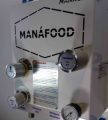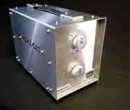
Complete Guide to Gas Mixers and its various applications
Autor: Miguel Gil
contato@managas.com.br
What gases are used in Modified Atmosphere Packaging (MAP) and food preservation?
Gases used in Modified Atmosphere Packaging (MAP) and Food Preservation
The gases most used in food preservation are Carbon Dioxide (CO2), Nitrogen (N2) and Oxygen (O2).
On a smaller scale, gases such as Carbon Monoxide (CO), Argon (Ar), Hydrogen (H2) and Helium (He) are also used.
Table of Contents:
1. Food Preservation: Modified Atmosphere Packaging
The oxygen contained in atmospheric air stimulates microbiological development, accelerating various deterioration processes in food, such as: change in color, texture, flavor and has a direct impact on reducing the shelf life.
Food preservation through the use of modified atmosphere packaging is carried out by removing air from the inside of the packaging and replacing it with a mixture of gases containing Oxygen (O2), Nitrogen (N2) and Carbon Dioxide (CO2) which involve the packaged food.
The choice of the gas mixture and respective concentration is influenced by the microbiota capable of growing in the food, sensitivity to Oxygen and Carbon Dioxide and stability of the desired color.
Example: preservation of oxymyoglobin in fresh red meat and nitrosomyoglobin in cured meat products.
2. Benefits of Modified Atmosphere Packaging
• Longer shelf-life/Extended shelf life/Better food quality
• Less waste
• More revenue
• Packaging more attractive to the consumer
For more information, check our Complete Guide to Modified Atmosphere Packaging, please follow the link below: https://www.managas.com.br/blog/conservacao-de-alimentos/como-aumentar-o-tempo-de-validade-de-alimentos-map-eam/
3. Modified Atmosphere Packaging: Oxygen
Oxygen (O2), generally stimulates the growth of aerobic bacteria and inhibits the growth of strict anaerobics, although there is a wide variation in the sensitivity of anaerobes to Oxygen (O2).
The presence of oxygen is more important in the storage of fresh meat in order to maintain the meat pigment, myoglobin in its oxygenated form, oxymyoglobin, which provides fresh meat with the characteristic red color. Low levels of oxygen (0.5%) can cause a brown color in chilled meats.
In addition, oxygen is responsible for many unwanted reactions in food, including oxidation and rancification of fats and oils, rapid ripening and senescence of fruits and vegetables, changes in color and deterioration caused by the growth of aerobic bacteria.
Thanks to the negative effects mentioned, O2 is generally avoided in the modified atmosphere packaging of several products.
On the other hand, its presence in small quantities is necessary for some foods. For example, in many fruits and vegetables, to allow their basic aerobic breathing processes and in red meat, to maintain the red color of fresh meat.
However, for most products packaged in a modified atmosphere, except fresh fruits, vegetables and certain meats, Oxygen is excluded or significantly reduced from packaging.
However, the presence of some Oxygen in the beginning can favor the growth of competitive microbiota such as lactic acid bacteria and, thus, help prevent the development of some anaerobic pathogens.
Some researchers have found that high concentrations of O2 have been effective in reducing the microbiota in different foods, such as minimally processed carrots, as they maintain their freshness and decrease the microbiota during prolonged storage.
4. Modified Atmosphere Packaging: Carbon Dioxide (CO2)
Carbon Dioxide is the main responsible for the bacteriostatic effect in modified atmosphere packaging.
The bacteriostatic effect generated by the presence of Carbon Dioxide is influenced by the initial bacterial load, the storage temperature and the type of packaged food. Its mode of action depends on the dissolution of the gas in the packaged product.
Additionally, the inhibitory effect of packaging in a modified atmosphere is directly related to the amount of carbon dioxide present.
The solubility of this gas is indirectly proportional to the storage temperature, so low temperatures have a synergistic effect on the bacteriostatic action of CO2.
It is important to note that when carbon dioxide CO2 dissolves in water, it acidifies the medium.
This acidification, as well as the antimicrobial effect of CO2 at concentrations greater than 10-15%, can suppress the growth of many deteriorating microorganisms and, for this reason, this gas becomes an important component of packaging in modified atmosphere and conservation of foods.
CO2 is soluble in water and fats and its absorption by food causes a small reduction in the volume of the gas and, consequently, can cause the packaging to collapse.
In foods with high humidity, such as red meat, poultry meat, fish, excessive CO2 absorption can cause the packaging to collapse, causing the product to have a slight vacuum packaging appearance.
In addition, packaging containing high concentrations of CO2 can cause an increase in exudate (liquid with a high protein content) in fresh meat.
5. Modified Atmosphere Packaging: Nitrogen (N2)
Nitrogen N2 is a chemically inert gas, tasteless and less prone to accidents than the other gases commonly used in modified atmosphere packaging.
Nitrogen N2 is used as a filling gas, replacing O2 oxygen as an alternative to vacuum packaging, since, as it is poorly soluble in water and fat, it is used to limit the collapse of the packaging caused by the absorption of CO2 by the product.
Nitrogen N2 has the characteristic of diffusing very slowly through plastic films and, therefore, remains longer in the package.
In addition, it slows oxidative rancification and inhibits the growth of aerobic microorganisms.
The mixture of gases used in modified atmosphere packaging (MAP) for different foods depends on the nature of the food and the likely mechanisms of deterioration.
When the deterioration is mainly microbial, the level of CO2 in the mixture must be as high as possible, limited only by the negative effects of CO2 in the food (for example: collapse of the packaging).
The typical gaseous composition in this situation is 30% to 60% CO2 and 40% to 70% N2.
For products that are very sensitive to Oxygen, in which deterioration occurs mainly through oxidative rancification, mixtures of 100% N2 or N2/CO2 (if microbial deterioration is also important in this food) are used.
For products that breathe, it is also important to avoid high CO2 or very low O2 concentrations (to avoid anaerobic respiration).
6. Modified Atmosphere Packaging: Carbon Monoxide (CO)
Carbon Monoxide (CO) is colorless, odorless and tasteless. Similar to Oxygen, Carbon Monoxide can be used to retain the red color of beef. The required carbon monoxide concentrations are minimal. However, it is very important to check local laws, as in some countries, including Europe, the use of Carbon Monoxide in modified atmospheres is still prohibited in food.
7. Modified Atmosphere Packaging: Argon (Ar)
Argon (Ar) is also inert, colorless, odorless and tasteless. With properties similar to Nitrogen, Argon can replace Nitrogen in many food applications. For some types of vegetables, there are indications that Argon inhibits enzymatic activities and metabolic reactions. However, the results are insignificant and due to the higher price than nitrogen, its use is rare in packaging.
8. Modified Atmosphere Packaging: Hydrogen (H2) and Helium (He)
Hydrogen (H2) and Helium (He) are also used in modified atmospheres for some applications. However, Hydrogen (H2) and Helium (He) are not adopted in order to prolong the shelf life of food. Due to their reduced molecular dimensions, both gases are used in some analyzers to detect leaks in packaging. As these gases do not have properties that contribute positively to food products and, in addition, they are expensive and difficult to handle, their use is restricted.
Questions related to Modified Atmosphere Packaging and Gases used for Food Preservation?
Any questions regarding the topic “What are the gases used in food preservation?”, please contact us. Also, take this opportunity to become acquainted with our gas mixers for food preservation and modified atmosphere packaging.

Dynamic gas mixer for mixing two to four gases, with adjustment of the gas concentration from 0 to 100%, control of the flow rate and outlet pressure of the gas mixture. Flow rate up to 3.6 m3/h.

Dynamic gas mixer for mixing two to four gases, with adjustment of the gas concentration from 0 to 100%, control of the flow rate and outlet pressure of the gas mixture. Flow rate up to 22 m3/h.

Dynamic gas mixer for mixing two to four gases, with adjustment of the gas concentration from 0 to 100%, control of the flow rate and outlet pressure of the gas mixture. Flow rate up to 46 m3/h, 74 m3/h, 97 m3/h and 150 m3/h.
